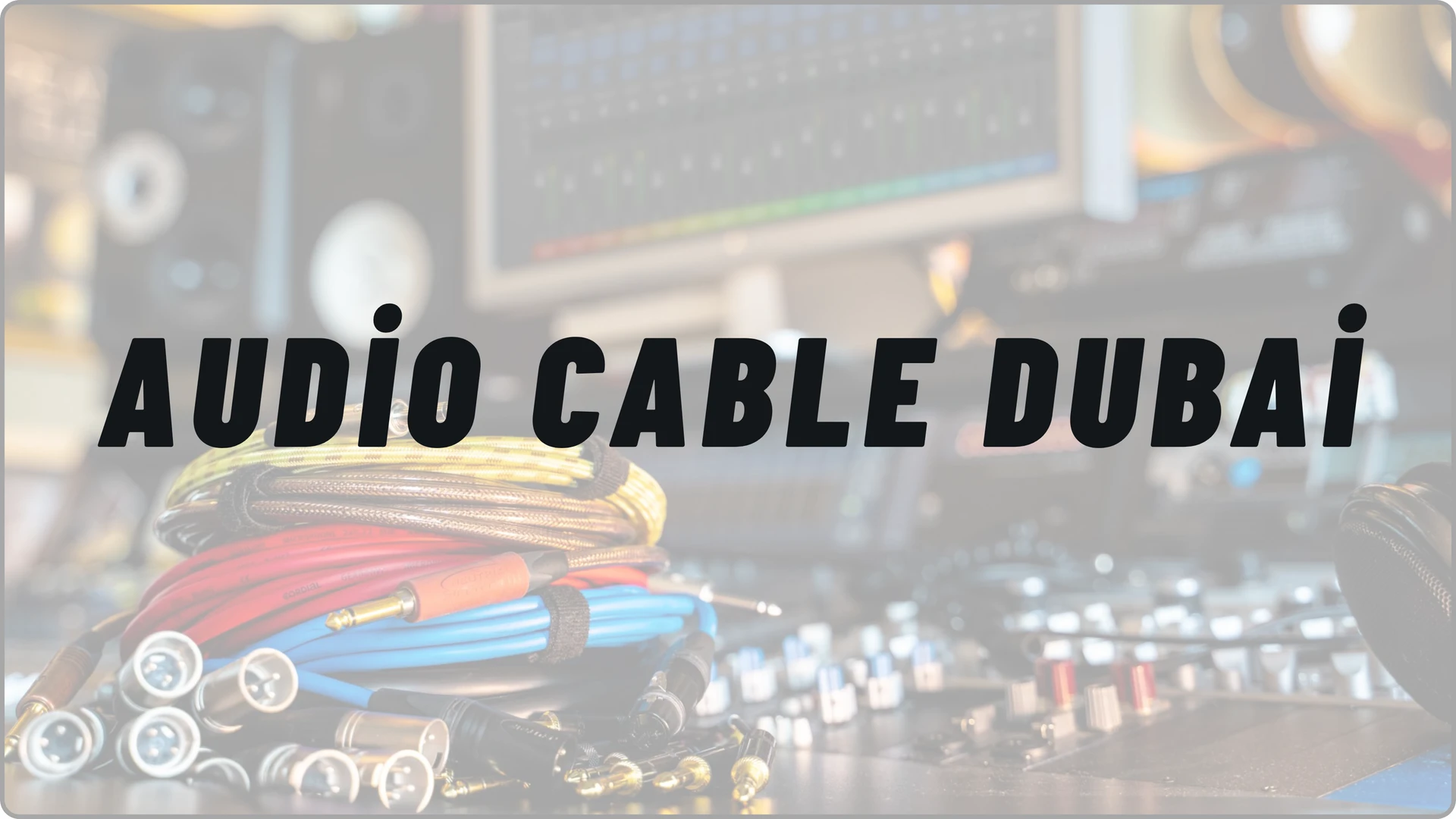All About Audio Cables in Dubai

All About Audio Cables in Dubai
Audio cables play a crucial role in our daily lives, even if we don’t always notice them. These cables connect our audio devices, like speakers, headphones, and microphones, allowing us to hear music, watch movies, and make phone calls. But what exactly are audio cables, and why are they so important for your audio setups?
Audio cables are simply wires with connectors at the ends that carry sound signals from one device to another. There are different types of audio cables, each designed for specific tasks. From the common 3.5mm headphone jack to the more complex XLR cables used in professional audio setups, these cables come in various shapes and sizes to fit different devices and needs.
In this blog, we’ll explore the world of audio cables, helping you make informed choices for your audio needs.
Types of Audio Cables
There are many different types of audio cables available, each with a unique set of features and applications. Let us divide them into two primary groups:
Analog Audio Cables
Analog audio cables transmit electrical signals that represent sound waves. They’re like the old-school, tried-and-true method of sending sound. There are so many cables like:
1. RCA Cables: These are the red and white cables often used to connect home theater systems, DVD players, and older audio equipment.
2. XLR Cables: XLR cables are commonly seen in professional audio setups, such as in recording studios or live sound systems. They’re known for their robust and balanced signal transmission, making them ideal for critical audio applications.
3. 1/4″ (6.35mm) Cables: You’ve probably seen these thick cables with a cylindrical plug at one end. They’re frequently used for instruments like electric guitars and amplifiers but can also be found in some studio connections.
Digital Audio Cables- The Future
Digital audio cables, on the other hand, transmit sound in a binary code of 0s and 1s, ensuring pristine audio quality and resistance to interference.
1. Optical (Toslink) Cables: These cables use pulses of light to transmit audio signals, making them immune to electromagnetic interference. They’re commonly used with home theater systems and some gaming consoles.
2. Coaxial Cables: Coaxial cables are similar to the familiar cable TV cables. They’re used for high-quality digital audio connections, often found in home theaters and some audio interfaces.
3. HDMI Cables: While primarily used for video, HDMI cables can also carry high-quality audio signals. They’re prevalent in modern home theater setups and connect devices like Blu-ray players and game consoles.
4. USB Cables:*USB cables aren’t just for data transfer; they can also carry digital audio signals. They’re commonly used to connect audio interfaces, microphones, and headphones to computers.
Choosing the Right Audio Cables in Dubai
Selecting the right audio cable might seem like a small task, but it can make a big difference in your audio experience. Let’s talk about some key steps to ensure you make the right choice when you buy audio cables in Dubai.
Before you pick a cable, take a close look at your audio equipment. Different devices have different input and output options. Check the available ports and connectors. By understanding your equipment, you’ll know which cables are compatible.
Consider how you plan to use the cable. Different applications have different requirements:
– Home Theater: For connecting your TV, speakers, and other audio devices, HDMI, optical, and RCA cables are common.
– Studio: If you’re working in a recording studio, XLR and 1/4″ cables are essential for high-quality audio.
– Gaming: Gamers often use 3.5mm or USB cables for headsets and gaming peripherals.
It’s not always necessary to use expensive cables, even if they can be enticing. Determine the audio needs and your budget. An inexpensive cable will often provide you with good service. Consider your needs and your budget when choosing cables because costly cables don’t always equate to higher sound quality.
Maintenance and Care
To keep audio cords working well and lasting a long time, they need to be handled and stored correctly. Care must be taken when working with audio cords. For the sake of the connectors and internal wires, don’t pull or yank on the cords themselves. While connecting or disconnecting wires, hold the connectors instead to keep them from breaking.
When not in use, store your cables carefully. Coiling them using the “over-under” technique is recommended to prevent kinks and tangles, which can degrade cable integrity. Additionally, protect the connectors from dust and physical damage when they’re not connected to devices.
Cable tangles can be a frustrating issue, but there’s a gentle way to untangle them. Avoid applying force or twisting the cables aggressively, as this can lead to permanent damage. Instead, patiently work through the tangles using your fingers.
Clean dirty or corroded connectors gently using a soft, dry cloth or a small brush. For more stubborn dirt or corrosion, a cotton swab with a small amount of rubbing alcohol can be used. Additionally, avoid exposing your cables to extreme temperatures, humidity, or direct sunlight, as these conditions can degrade cable materials over time.
Future Trends in Audio Cable in Dubai
The audio cable industry in Dubai is witnessing the emergence of innovative technologies that promise to enhance sound quality and convenience. Some of these technologies include:
1. Fiber-optic cables, like those used in Toslink connections, are becoming more prevalent due to their ability to transmit high-quality digital audio signals over long distances without interference.
2. Smart Cables: With the integration of microprocessors and sensors, future audio cables may become “smart.” These cables could automatically detect and adjust settings to optimize audio quality, making them more user-friendly and adaptable to various setups.
FAQs
What’s the difference between analog and digital audio cables?
Analog audio cables transmit sound as electrical signals, while digital audio cables transmit sound as binary data (0s and 1s). Analog is typically used for traditional audio, while digital is common in modern devices for higher fidelity.
Are expensive audio cables worth it for better sound quality?
Not necessarily. While quality matters, the price doesn’t always correlate with better sound. Well-matched, reasonably priced cables often deliver the desired audio quality.
How can I prevent audio interference and noise in my system?
Ensure proper grounding, separate power, and audio cables, and use quality shielded cables. Identifying and eliminating potential sources of interference can significantly improve audio quality.
Do cable connectors affect sound quality?
Connector quality can influence sound, but it’s usually subtle. Gold-plated connectors resist corrosion, ensuring long-term reliability, while high-quality connectors may offer marginally better conductivity.
How can I clean audio cables and connectors?
Use a soft, dry cloth or a small brush to clean connectors gently. For stubborn dirt or corrosion, a cotton swab with a bit of rubbing alcohol can be effective. Always handle connectors with care.
Should I go wireless or stick with wired audio connections?
It depends on your needs. Wired connections provide stability and higher fidelity, making them ideal for critical applications. Wireless options are convenient for everyday use but may sacrifice some audio quality.
Are there eco-friendly audio cables available?
Yes, sustainable audio cables made from recycled materials and designed for durability are becoming more prevalent. Look for cables from manufacturers committed to reducing environmental impact.
What’s the ideal way to store audio cables?
Store cables coiled loosely in a cool, dry place. Avoid tight winding or exposing them to extreme temperatures. Proper storage prevents damage and prolongs cable life.
What should I do if my audio cable gets tangled?
Gently untangle the cable using your fingers, avoiding forceful pulling or twisting. Prevention is key, so lay cables flat when possible and use cable management solutions to minimize tangling.
In conclusion, audio cables play a Major role in delivering the sounds we cherish. By understanding their types, caring for them properly, and selecting the right ones, we can ensure the best possible audio experiences. Remember, the world of audio equipment is rich and ever-changing, so don’t hesitate to explore and discover new ways to enjoy the magic of sound.







